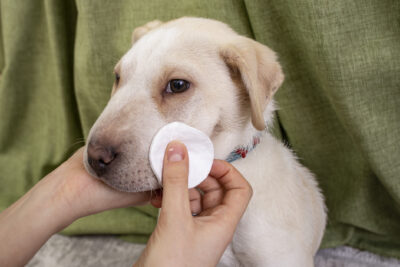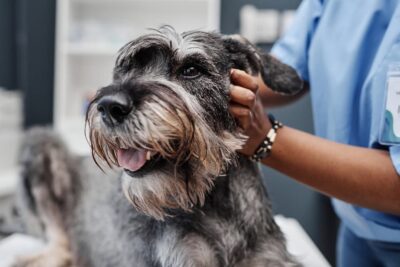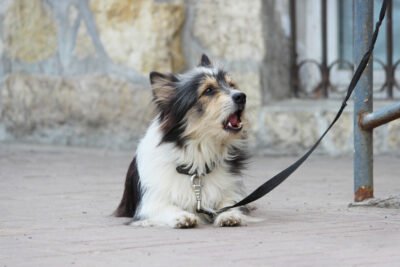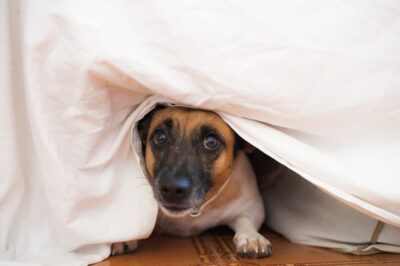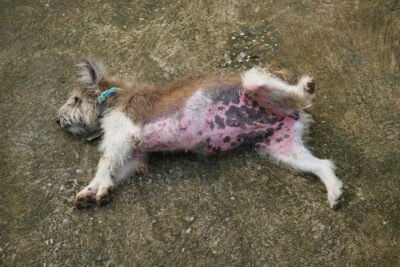Are Dogs’ Mouths Cleaner Than Humans’?

All featured products are chosen at the discretion of the GreatPetCare editorial team and do not reflect a direct endorsement by the author or reviewer.
In many ways, a dog’s mouth is much like a human’s mouth. Dogs develop tartar buildup, benefit from getting their teeth brushed, and have roughly the same amount of mouth bacteria as we do.
In contrast, dogs are not as prone to developing cavities as we are. And flossing (something we practice for good dental health) isn’t something veterinarians recommend for dogs. These similarities and differences prompt the question: are dogs’ mouths cleaner than humans’ mouths?
To provide a clear answer, we asked veterinarians to weigh in — because understanding how our dogs’ mouths work can ultimately help us provide them with optimal dental care.
In addition to reading this article, we recommend initiating a conversation with your veterinarian about your dog’s specific oral hygiene needs.
Origins of “A Dog’s Mouth is Cleaner Than a Human’s”
Although it’s not entirely clear how this idea originated, a look back to ancient Egyptian and Greek civilizations provides a clue. These societies believed in the healing properties of dog saliva, so much so that they would let dogs lick their wounds. [1]
There’s a sliver of truth to this belief. Dog saliva does indeed have antibacterial properties that fight Escherichia coli and Streptococcus canis. [2] However, it is a fact that has been exaggerated with time, says Dr. Jeremy Kimmelstiel, medical director at Bond Vet, based in New York City. “While dog saliva does contain some enzymes with potential antibacterial properties, it is not a cure-all and should not be considered a substitute for proper medical treatment.”
Dog saliva can, in fact, cause harm to humans. “Letting a dog lick your wound can lead to infection. And the bacteria in their mouth could be harmful to the very young, the elderly, and the immunocompromised,” [3] explains Dr. Don LeHoullier, owner of Countryside Veterinary Clinic in Jefferson, Oregon. Dogs can transmit a number of viral and bacterial diseases to humans through infected saliva, such as norovirus, Salmonella, and staph (Staphylococcus) [4].
There may be a more recent explanation for the interest in dog mouth bacteria. “I suspect that part of that belief [that dog mouths are cleaner] is from dental care not being prioritized in dog healthcare 30 to 40 years ago,” shares Dr. Amber Karwacki, a partner doctor at Heart + Paw’s Callowhill location in Philadelphia. “More recently, dental care has become a priority during annual exams, and our recommendations have changed for dental care.” (More on this in a bit!)
Facing Off: Dog Mouth vs Human Mouth

So, let’s get into it: are dogs’ mouths cleaner than humans’ mouths? The following comparisons and contrasts provide some clarity.
Bacteria in the Mouth
Both the human mouth and dog mouth contain roughly 600 types of bacteria each. Although the levels of bacteria are similar, scientists estimate that we share just 16.4 percent of them in common with our dogs. [5]
One we both share in common is Porphyromonas, the bacterium most linked to periodontal disease. “The difference is humans have the species P. gingivalis and dogs have the species P. gulae,” explains Dr. Karwacki.
Cavity Frequency
Did you know that dogs are less prone to cavities than humans? Given that dogs don’t get their teeth brushed as often as we do, this may seem counterintuitive. Dog saliva, however, is much less acidic than ours. Acid erodes tooth enamel (the thin, protective layer that defends against cavities and decay).
Additionally, dog teeth are spaced farther apart than ours, providing fewer opportunities for food and debris to become trapped. They also have more conical teeth with fewer pits when compared to our teeth. It also helps, of course, that dogs don’t consume as many sugary foods as we do.
Oral Hygiene
Dentists recommend that we brush and floss every day to remove plaque and debris. Similarly, veterinarians also advise pet parents to brush their dogs’ teeth daily. That’s where the similarities end, though.
Veterinarians say that flossing dog teeth — at least the way we floss using a thin string — is not a recommended practice. It’s not just that attempting to floss a dog’s teeth would likely be an exercise in futility. Dental floss can also contain xylitol (a toxin for dogs) and result in intestinal blockage if ingested.
Though it’s not a replacement for proper brushing and flossing, gargling with certain types of mouthwash can help reduce plaque in our own teeth. [6] While dogs obviously can’t gargle, “A water additive can be used in their water bowl that can help slow down tartar,” says Dr. Karwacki.
Water additives formulated for dogs help prevent (and slow) plaque accumulation with enzymes that alter the pH of dog saliva. Some of these rinses don’t have scent or taste, so your dog doesn’t even have to know. An added benefit of water additives? Fresher dog breath.
Professional Teeth Cleaning Procedures
Professional dog dental care cleanings are performed much like the ones we get at the dentist. In both procedures, similar tools (including polishers, scrapers, and scalers) are used. Additionally, “During the cleaning, radiographs are taken of the teeth to examine the tooth roots just like what would happen at a human dental office,” explains Dr. Karwacki.
The difference in procedures is that dogs need to be sedated. Anesthesia alleviates the stress and pain resulting from all that poking and prodding. It also allows the veterinary team to perform the procedure effectively without having to constantly restrain the dog.
Chewing
Research shows that in humans, chewing sugarless gum for 20 minutes after eating can help prevent decay. [7] Similarly, “for dogs, chewing on appropriate items like dental chews or hard toys can help reduce plaque and tartar buildup,” says Dr. Kimmelstiel.
Products like ORAVET® Dental Hygiene Chews provide dual protection. Manual chewing dislodges plaque, while the added delmopinol forms a barrier around the teeth to prevent plaque and tartar accumulation.
Chewing isn’t a substitute for proper oral hygiene though, veterinarians say. Proper dog dental care still consists of regular brushing and professional dental cleanings.

Avoiding Foods with Sugar
There’s a reason human dentists advise against overuse of sugary foods and beverages. [8] As we consume sugar, the bacteria in our mouths produce an acid that becomes plaque when combined with saliva. Plaque erodes the enamel that protects our teeth, which can lead to cavities.
Because sugar can also cause cavities and tooth decay in dogs, veterinarians recommend not feeding them sugary human foods, or dog foods and snacks containing too much sugar.
Are Dogs’ Mouths Cleaner Than Humans’? The Verdict from Vets
Keeping all of this in mind, what’s the final verdict?
It’s a tough comparison to make, namely because we’re different species — one of which is not actually in charge of their oral hygiene. “Each has its own unique bacteria and hygiene considerations,” says Dr. Kimmelstiel. And with an estimated 84 percent contrast in mouth bacteria, we’re susceptible to developing different types of diseases and health concerns.
This doesn’t even take into consideration novel micro-organisms that individual dogs may contract. “Dogs like to put things in their mouth, such as animal feces, which can introduce new bacteria to their mouths,” says Dr. Karwacki.
Another factor to consider is that more than 80 percent of dogs are afflicted by some degree of periodontal disease. If their mouths were truly cleaner than ours, this number would likely not be as high as it is.
So, while it’s not 100 percent proven, we suspect that a dog’s mouth is likely not cleaner than a human’s mouth.
How to Keep Your Dog’s Mouth Clean

Tending to your dog’s oral hygiene needs goes a long way in preventing dental disease and promoting overall health. Our veterinary-recommended tips can help you navigate this important aspect of your dog’s wellness plan.
Brush Your Dog’s Teeth Regularly
Brushing a dog’s teeth is essential for removing the plaque that can eventually lead to serious dental issues. How often should you be brushing your furry friend’s teeth, though? “Daily is best, but if not possible, several times a week can be helpful,” recommends Dr. LeHoullier.
Veterinarians say it’s best to start getting your dog accustomed to a toothbrush at a young age. Because this isn’t always possible, we’ve designed a simple step-by-step guide to brushing a dog’s teeth that will help you become a pro in no time.
Though veterinarians recommend using a toothbrush designed for dogs, you may be able to get away with one designed for human babies. One thing that’s non-negotiable? The type of toothpaste you use: it should be formulated specifically for pets. Human toothpaste contains ingredients known to be toxic to dogs.
Keep Your Dog’s Dental Cleaning and Veterinary Wellness Appointments
Schedule regular professional dental cleanings with your veterinarian to remove tartar buildup and address any underlying issues, recommends Dr. Kimmelstiel.
A test called OraStripdx detects periodontal disease in dogs (and cats) in just 10 seconds without the need for sedation. [9] The technology was introduced very recently, however, so it may not be widely used yet.
Routine veterinary wellness checkups are also important. They “allow the veterinarian to assess your dog’s oral health and address any emerging problems,” says Dr. Kimmelstiel.
Ask Your Veterinarian About Alternative Dental Cleaners
If you’ve tried everything and your dog is still unreceptive to brushing, Dr. Karwacki says dental chews can help slow down tartar buildup. “Dental water additives can also be used if the other two methods do not work.”
Though alternatives can provide some benefit, veterinarians stress that they don’t take the place of regular brushing and veterinary cleanings.
Feed Your Dog a Healthy Diet
Provide your dog with a balanced diet that promotes overall health, including dental health, recommends Dr. Kimmelstiel. “Consult with a veterinarian to determine the best diet for your dog’s specific needs.”
If needed, veterinary-prescribed dental diets are available that work to reduce buildup and improve overall dental health. Hill’s, Purina, and Royal Canin each have their own versions.
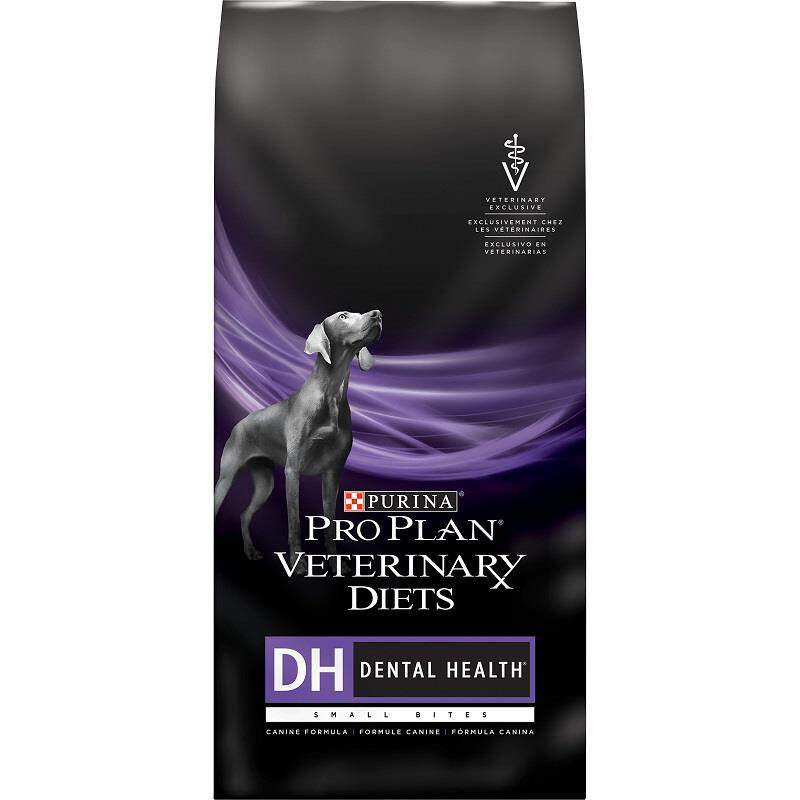

Budget for Dog Dental Care
Don’t forget to plan ahead for your dog’s dental care needs, whether through pet insurance plans, wellness plans, or financing.
References
- “Does Dog Saliva Have Healing Powers?” (2015, October). SiOWfa15: “Science in Our World: Certainty and Controversy.” Penn State. Retrieved from: https://sites.psu.edu/siowfa15/2015/10/21/does-dog-saliva-have-healing-powers/
- Hart, B., Powell, K. (1990, September). “Antibacterial Properties of Saliva: Role in Maternal Periparturient Grooming and in Licking Wounds.” Physiology & Behavior. ScienceDirect. Retrieved from: https://www.sciencedirect.com/science/article/abs/pii/003193849090332X
- Hasan, J., Hug, M. (2023, May). Pasteurella Multocida. StatPearls. National Library of Medicine. Retrieved from: https://www.ncbi.nlm.nih.gov/books/NBK557629/
- Ghasemzadeh I, Namazi SH. “Review of Bacterial and Viral Zoonotic Infections Transmitted by Dogs.” (2015) J Med Life. (Spec Iss 4):1-5. PMID: 28316698; PMCID: PMC5319273. Retrieved from: https://www.ncbi.nlm.nih.gov/books/NBK430685/
- Dewhirst, F., Klein, E., etal. (2012, April). “The Canine Oral Microbiome.” PLoS One. National Library of Medicine. Retrieved from: https://www.ncbi.nlm.nih.gov/pmc/articles/PMC3338629/
- Mouth Rinse (Mouthwash). (n.d.). American Dental Association. Retrieved from https://www.ada.org/en/resources/research/science-and-research-institute/oral-health-topics/mouthrinse-mouthwash
- Chewing Gum. (n.d.). MouthHealthy by the American Dental Association. Retrieved from: https://www.mouthhealthy.org/all-topics-a-z/chewing-gum
- Nutrition and Oral Health (n.d.). American Dental Association. Retrieved from: https://www.ada.org/en/resources/research/science-and-research-institute/oral-health-topics/nutrition-and-oral-health
- “New Test for Early Detection of Periodontal Disease in Dogs and Cats is Launched.” (2023, March). Fetch DVM360. Retrieved from: https://www.dvm360.com/view/new-test-for-early-detection-of-periodontal-disease-in-dogs-and-cats-is-launched
